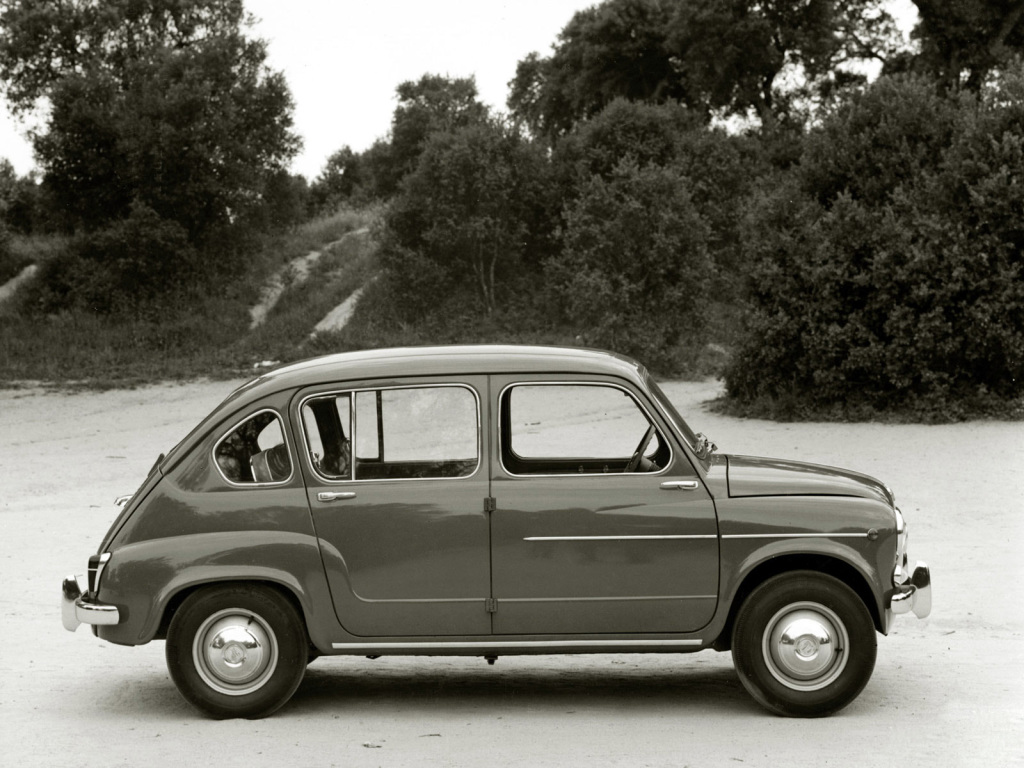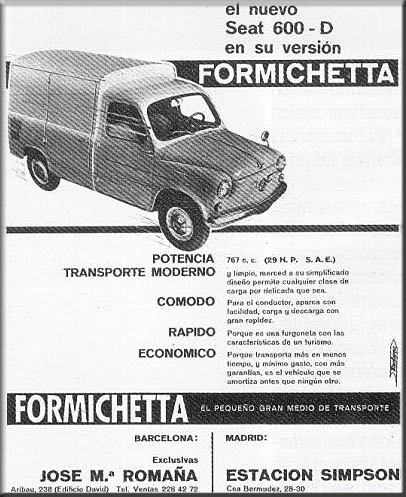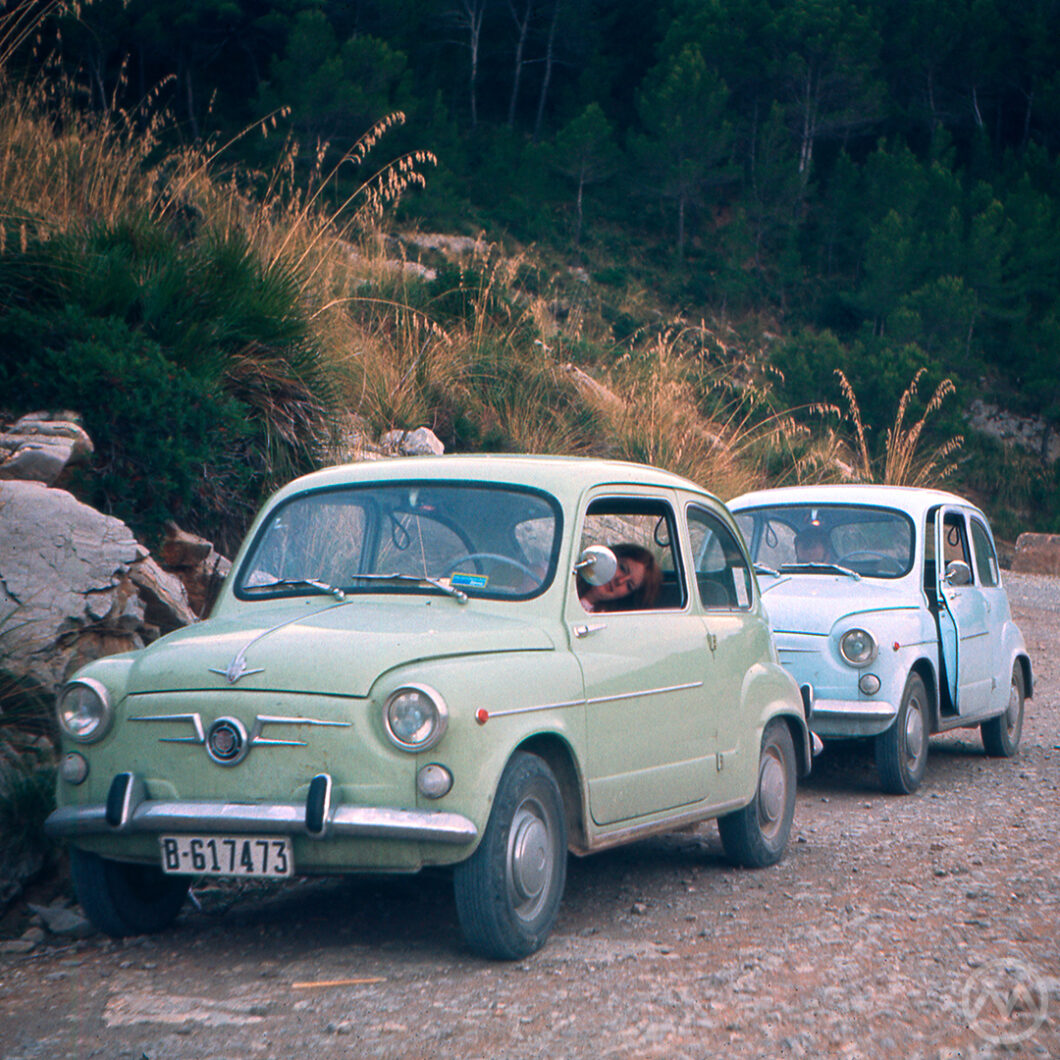It’s too late for a Friday Fiat, but how about a Sunday SEAT? Por qué no los dos? The Fiat 600 was designed in Italy by Dante Giacosa and Co., but starting in the spring of 1957, it also became the car that put Spain on wheels as the SEAT 600. These two Seiscientos, from the OldMotors slide archive, are pictured somewhere in the Sierra de Collserola in September 1969.
Fittingly, the lead car has Barcelona plates. Today, the Sierra de Collserola is mostly a national park with towers above Barcelona, and the cars were only built a few miles away in the Zona Franca, a duty-free industrial area on the water not far from El Prat airport. Today, the old factory still makes car parts, but in the time of the 600, it was Spain’s first major auto plant, and the 600 was the country’s first true mass-market domestic car.
The origins of SEAT (pronounced Seeh-aht) go back to 1939, when a group of bankers and industrialists, including backers of existing concerns like Hispano-Suiza, decided to address Spain’s lack of a mass-market automaker. This private idea was nationalized in 1942, but put on hold for another five years because of WW2.
Sociedad Española de Automóviles de Turismo
Spain was a poor country with awful roads in the first half of the 20th century, and it didn’t have a large industrial base. What little auto industry the country had, including transplant factories from some foreign makers, was dealt heavy setbacks by the Civil War. The only major automaker was Hispano, which built luxury cars that very few Spaniards could ever afford.
Post-civil-war economic recovery was painfully slow. However, the bankers and the state-run Instituto Nacional de Industria (INI) that displaced them understood that mass-market car production, as in other countries, could be a major economic engine. The key was finding a partner who could help establish a factory and provide licensed designs. INI considered two major partners, Fiat and (ironically) Volkswagen, but in 1948, Fiat was in far better shape and its capabilities more suited to INI’s goals.
Fiat had been one of the transplant automakers building cars in Spain in the 1930s before the war, so it had a local history. Like Spain, Italy was a protectionist market, and there were lots of similarities between the two markets. Fiat specialized in durable, cheap cars and its license work with Simca in France was similar to what the Spaniards wanted. After signing with Fiat, Sociedad Española de Automóviles de Turismo, S.A. (SEAT) was born in May 1950 and construction of the Barcelona factory began.
SEAT’s first leader was José Ortiz-Echagüe, an engineer, pilot, and photographer who had founded airplane maker CASA in 1923. Echagüe was already 64 years old in 1950. Still, he was probably one of Spain’s most capable industrialists, with a keen grasp of both how to design vehicles and how to engineer their production lines. CASA would later become part of Airbus, and Echagüe was a keen pilot all his life. In 1959, when CASA was under contract to maintain U.S. and NATO aircraft, he even flew an F-100 Sabre at age 72.
SEAT 600
Echagüe, with assistance from Fiat, helped create the Zona Franca plant and oversaw it well into the 1960s. The next step was actually building cars. The first model, suggested by Fiat commercial director Luigi Gajal, was the 1400.
Production began in the spring of 1953, but this car was really meant as a test run for SEAT’s factory. It wasn’t a bad car, but as in Italy, the 1400 was too big and pricey for most Spaniards. But after four years of cranking them out, the time arrived for SEAT’s real goal, mass-market affordable cars in the form of the 600, which debuted in Italy in 1955 and was an instant market success.
Mechanically, the SEAT was essentially identical to the Fiat, complete with suicide doors and a 633-cc, 21.5-hp four. “Progetto 100” had been designed by Giacosa’s team to seat four and reach roughly 60 mph while returning 45 mpg. It was water-cooled, so more complicated than the VW Beetle, but nearly as simple.
In Italy and Spain, the engine was eventually enlarged to 767cc and 25 hp, and tuning firms soon set about making absurd hot rod versions of both. The SEAT and Fiat versions eventually diverged though, with SEAT adding a convertible “Descapotable” in 1958. In time, SEAT built many more versions than Fiat did.

Los Variaciones
These included a low-cost commercial van version with blanked rear windows, a full-on cutaway van suitable for different service bodies, and a variety of custom bodies from Siata Española, the Spanish arm of Turin-based Siata, inluding a practical commercial van called the Formichetta. The Siata models started with a van, but soon also encompassed coupes and convertibles. The most practical version was the four-door 800, with its stretched body made in a separate factory on a semi-coachbuilt basis.
There were also luxury 600s, but the basic design kept its suicide doors for far longer than versions in other countries, until 1969 in fact. Though sales ramped up only gradually, the 600 was a hit from day one. It annihilated both imported and domestic microcars, the only other “affordable” cars in Spain, particularly the Voisin-designed Biscúter. That model had looked promising, but the much more normal and properly-sized SEAT made it look primitive despite its lightweight aluminum body and exotic origins.

By far the best-selling Spanish car of the 1950s and 1960s, the 600 would remain in production until late August of 1973 and be omnipresent on Spanish streets for decades. Some things, like the transverse front leaf spring suspension, rear-trailing arms, and four-speed gearbox, never really changed, but the car was gradually upgraded. It also taught SEAT how to build cars and to experiment with its own designs, like the 800. In time, it also became the company’s first export model.
While the company started building the 600-based Fiat 850 in 1965, it made that car its own as well, complete with another four-door model; and SEAT used the 600/850 engineering to develop a unique successor to the 600, the SEAT 133, sometimes exported as a Fiat.
SEAT’s growing creativity and desire for autonomy in the 1970s eventually put it in conflict with Fiat, which led to an acrimonious divorce in the 1980s and a short period of independence. In that era, it started to ally with Volkswagen, eventually leading VW to buy the company in 1986.

